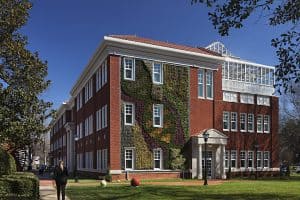
The Basics of WELL Building Design
Carolyn Rickard-Brideau, AIA, LEED AP BD+C, WELL AP (Provisional), Partner and Global Practice Leader for Workplace with Little, is one of the nation’s select few experts in the field of WELL Building Design. She was the afternoon keynote speaker at Clemson University’s 2nd Annual Construction Industry Symposium (2017) in Greenville, South Carolina.
What if I told you that your health can be positively — or negatively — impacted by spaces in which you spend your time? Would you seek out spaces that have a positive effect on your health and productivity, and avoid those with negative effects? Our bodies respond to cues in our environment, beyond our conscious awareness, and much of what is designed and built today is giving our systems the wrong messages.
There is a field of design called salutogenic design. Salutogenesis, meaning “the origins of health,” deals with the relationships between stress, wellness and human health. Salutogenic design focuses on the positive impact of different spaces on human health. It’s a measurable aspect of design that can help a building’s inhabitants operate at their peak performance, maintaining physical and mental well-being, actually helping them lead healthier, and potentially longer lives.
The unfortunate thing is that very few design professionals and even fewer organizations recognize the benefits of salutogenic design. However, we are on the cusp of a change. Gradually companies and organizations are seeing wellness as a significant differentiator to the people they are seeking to recruit and retain as the ultimate investment in people, in an architectural sense.
Salutogenic design is being endorsed in the design profession through vehicles like the WELL Building Standard, which focus not only on features fairly common to the industry, such as air, water, and light; they also hone in on program elements associated with comfort, nourishment, fitness and mind – most likely new concepts for people to associate with the built environment.

The brain is the dominant organ of the human body that’s directing the rest of our systems as they interact with the built environment. When building design takes in account the way the brain responds to its environment, and how that environment supports brain function, the result is better health and wellness outcomes for the people who come in contact with that building. The good news is that there are many active and passive ways to design these features into your building or your day.
Active Design
From our time as hunter-gatherers the human body evolved to run 5-9 miles per day, which is why your Fitbit wants you to walk 10,000 steps every day or roughly 5 miles. Humans spent most of their time outdoors while the sun was out, foraging and finding their next meal. Today, very few people meet that mileage on a daily basis. Most of us know that regular exercise is good for us physically, but regular physical activity also helps our brains.
We know, from experiments done by Fred Gage, Adler Professor in the Laboratory of Genetics at the Salk Institute, that regular exercise results in a growth of neurons in the part of the brain that helps us navigate, and where short-term memories are consolidated into long-term memories. In fact, his research showed a 15% growth in those neurons. It also showed that regular physical activity helped people suffering from brain injuries to re-learn how to speak and walk, a phenomenon called neuroplasticity. Neuroplasticity is something that helps our brains remain active and sharp as we age.
Americans now spend 90% of our time indoors, and 47% of that time is in front of screens. This is obviously not running 5-9 miles a day, and it’s resulting in a condition called Sitting Disease. Sitting Disease, while not caused by a bacterial agent like many diseases, essentially captures the cost of a sedentary lifestyle and it can lead to serious, chronic health conditions.
The simplest ways to alleviate sitting disease is to incorporate elements that help people get more active as an extension of their natural activities in a building. Examples like sit-stand desks that allow people to change posture during the day, designing a unique stair that everyone will want to use, or marking a path through or around an office with distances marked, or creating a central coffee bar hub — even something as simple as not having personal trash cans but creating a centrally located one — anything to get people up and out of their seats on a regular basis helps.
Biophilia
“Get back to nature.” People use this phrase when they want to talk about simplifying their day, and shedding the frantic pace and stress that defines many modern lives. It may seem like a convenient metaphor, but the feeling behind it is rooted in real, scientifically verified benefits for humans. We know humans have a built-in response to nature. The human response to exposure to nature results in a number of benefits that reinforce human health, wellness and performance.
The concept of biophilia — literally, “a love of nature” — in human spaces is gaining traction in every kind of space across the globe. Ways to incorporate biophilic elements in space are easier than you might think. Using natural materials, or those that incorporate natural patterns profit that health boost. Imagine the variety of experiences you have outside, in nature. Daylight shifts and changes, shadows from trees move with the wind… shimmering light reflects off of water… and gentle breezes move through the air. Adding elements to your built environment that share the dynamic or changing qualities of these natural phenomena helps engage people who are exposed to them, and provides variety and richness in these spaces.

Circadian Rhythm
A neuroscientist once told me that the most important act in nature is the sun’s progress across the sky. Not just because it provides a wonderful sunrise or sunset, but because of how it tells our bodies to act during the day.
Our bodies have something called a circadian rhythm — think of it as a 24-hour “To Do” list for your body functions — and it’s driven by the sun. The human brain has a small structure, called the SCN, that reads the color of the sun during the day, and responds accordingly, raising and lowering our blood pressure, and body temperature during the day, releasing hormones that help us wake up or ready us for sleep, and running all of our major organs. While it’s not generally perceptible to the eye, morning light is blue in color. The SCN reads that and release hormones that help us wake up and get going. Evening sun is yellow in color, and our SCN sees that and releases melatonin, a different hormone that helps ready us for sleep and restoration.
When we don’t have access to natural daylight our bodies are looking for cues from our environment that they’re not getting. This results in the disruption of the circadian rhythm and the sleep-wake cycle. Spending much of our evening time on devices — which emit blue light — is giving our bodies the wrong messages, telling them to wake up instead of sleep, and laying the foundation for lasting, chronic illnesses like obesity, diabetes, heart disease and cancer.
So when designing space, it’s best to open up the window line, and to bounce sun as deeply into a space as possible so that everyone in the space has access to daylight. This means placing walled spaces near the building core to leave the window line free, or glazing the front of walled spaces so as not to disrupt the passage of daylight.
The most neglected opportunity in buildings today is the creation and use of outdoor space immediately adjacent to the building, as usable space. Creating outdoor environments people can take advantage of supports posture change, exposes people to nature and natural daylight and uses “forgotten” space in a way that maximizes whole site utilization, while providing a measurable benefit.
The most important thing to remember is that the buildings and spaces we occupy on a daily basis can support meaningful, positive impacts on the health of the people coming in contact with those spaces, and have a significant impact on the wellness, productivity and lifespans of the people using them.

Carolyn Rickard-Brideau is a Partner, and the Global Practice Leader for Workplace at Little, a multidisciplinary design firm with offices in Charlotte, Durham, Washington, DC, Orlando, Los Angeles and Beijing. In the last decade Carol has explored the scientific basis for the relationship between architecture and human neurobiology. She is a vocal advocate for salutogenic design and its focus on increasing human wellness, happiness and productivity. She also does outreach and lecturing on the importance of WELL design to both design schools and professional organizations across the country.





